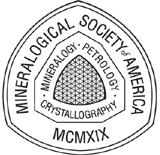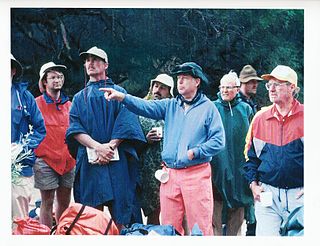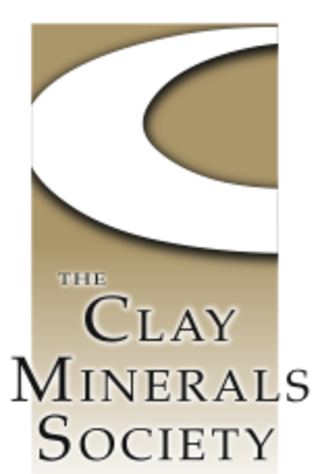Related Research Articles

Petroleum engineering is a field of engineering concerned with the activities related to the production of Hydrocarbons, which can be either crude oil or natural gas. Exploration and production are deemed to fall within the upstream sector of the oil and gas industry. Exploration, by earth scientists, and petroleum engineering are the oil and gas industry's two main subsurface disciplines, which focus on maximizing economic recovery of hydrocarbons from subsurface reservoirs. Petroleum geology and geophysics focus on provision of a static description of the hydrocarbon reservoir rock, while petroleum engineering focuses on estimation of the recoverable volume of this resource using a detailed understanding of the physical behavior of oil, water and gas within porous rock at very high pressure.

The Geological Society of London, known commonly as the Geological Society, is a learned society based in the United Kingdom. It is the oldest national geological society in the world and the largest in Europe, with more than 12,000 Fellows.
Organic geochemistry is the study of the impacts and processes that organisms have had on the Earth. It is mainly concerned with the composition and mode of origin of organic matter in rocks and in bodies of water. The study of organic geochemistry is traced to the work of Alfred E. Treibs, "the father of organic geochemistry." Treibs first isolated metalloporphyrins from petroleum. This discovery established the biological origin of petroleum, which was previously poorly understood. Metalloporphyrins in general are highly stable organic compounds, and the detailed structures of the extracted derivatives made clear that they originated from chlorophyll.
The American Association of Petroleum Geologists (AAPG) is one of the world's largest professional geological societies with more than 40,000 members across 129 countries as of 2021. The AAPG works to "advance the science of geology, especially as it relates to petroleum, natural gas, other subsurface fluids, and mineral resources; to promote the technology of exploring for, finding, and producing these materials in an economically and environmentally sound manner; and to advance the professional well-being of its members." The AAPG was founded in 1917 and is headquartered in Tulsa, Oklahoma; currently almost one-third of its members live outside the United States.

The Society of Exploration Geophysicists (SEG) is a learned society dedicated to promoting the science and education of exploration geophysics in particular and geophysics in general. The Society fosters the expert and ethical practice of geophysics in the exploration and development of natural resources, in characterizing the near-surface, and in mitigating earth hazards. As of November 2019, SEG has more than 14,000 members working in more than 114 countries. SEG was founded in 1930 in Houston, Texas but its business office has been headquartered in Tulsa, Oklahoma since the mid-1940s. While most SEG members are involved in exploration for petroleum, SEG members also are involved in application of geophysics methods to mineral exploration as well as environmental and engineering problems, archaeology, and other scientific endeavors. SEG publishes The Leading Edge (TLE), a monthly professional magazine, Geophysics, a peer-reviewed archival publication, and Interpretation, a peer-reviewed journal co-published by SEG and the American Association of Petroleum Geologists.

The Mineralogical Society of America (MSA) is a scientific membership organization. MSA was founded in 1919 for the advancement of mineralogy, crystallography, geochemistry, and petrology, and promotion of their uses in other sciences, industry, and the arts. It encourages fundamental research about natural materials; supports the teaching of mineralogical concepts and procedures to students of mineralogy and related arts and sciences; and attempts to raise the scientific literacy of society with respect to issues involving mineralogy. The Society encourages the general preservation of mineral collections, displays, mineral localities, type minerals and scientific data. MSA represents the United States with regard to the science of mineralogy in any international context. The Society was incorporated in 1937 and approved as a nonprofit organization in 1959.

The Geochemical Society is a nonprofit scientific organization founded to encourage the application of chemistry to solve problems involving geology and cosmology. The society promotes understanding of geochemistry through the annual Goldschmidt Conference, publication of a peer-reviewed journal and electronic newsletter, awards programs recognizing significant accomplishments in the field, and student development programs. The society's offices are located on the campus of the Carnegie Institution for Science in Washington, DC.

Fred F. Meissner was an American geologist and engineer who contributed to the fields of geology, geophysics, engineering, petroleum engineering, geochemistry, mineralogy, physics, mining, economic geology, and fishing.
Xie Xuejin was a Chinese geochemist who won the AAG Gold Medal in 2007. Xie was considered as the Father of Geochemical Mapping in China.

A geologist is a scientist who studies the solid, liquid, and gaseous matter that constitutes Earth and other terrestrial planets, as well as the processes that shape them. Geologists usually study geology, earth science, or geophysics, although backgrounds in physics, chemistry, biology, and other sciences are also useful. Field research is an important component of geology, although many subdisciplines incorporate laboratory and digitalized work. Geologists can be classified in a larger group of scientists, called geoscientists.
The European Association of Geochemistry (EAG) is a pan-European organization founded to promotes geochemical research. The EAG organizes conferences, meetings and educational courses for geochemists in Europe, including the Goldschmidt Conference which it co-sponsors with the North American Geochemical Society.
Syed Mahmood Naqvi was an Indian Earth scientist specialising in geochemistry at the National Geophysical Research Institute (NGRI) in Hyderabad. In a four-decade career, from the 1960s through 2000s, he was the recipient of numerous awards, scientific as well as humanitarian, and served as Fellow of the Association of Applied Geochemists, Indian Geophysical Union, Andhra Pradesh Academy of Sciences and Indian National Science Academy (INSA) as well as vice-president of the Geological Society of India, the Geological Mining and Metallurgical Society of India and the Indian Society of Applied Geochemists (ISAG).
Elements: An International Magazine of Mineralogy, Geochemistry, and Petrology is a bimonthly peer-reviewed scientific journal published by 18 scientific societies: Mineralogical Society of America, Mineralogical Society of Great Britain and Ireland, Mineralogical Association of Canada, Clay Minerals Society, Geochemical Society, European Association of Geochemistry, International Association of GeoChemistry, Société Française de Minéralogie et de Cristallographie, Association of Applied Geochemists, Deutsche Mineralogische Gesellschaft, Società Italiana di Mineralogia e Petrologia, International Association of Geoanalysts, Polskie Towarzystwo Mineralogiczne, Sociedad Española de Mineralogía, Swiss Society of Mineralogy and Petrology, Meteoritical Society, Japan Association of Mineralogical Sciences and the International Association on the Genesis of Ore Deposits. It was established in January 2005.
Geochemical modeling or theoretical geochemistry is the practice of using chemical thermodynamics, chemical kinetics, or both, to analyze the chemical reactions that affect geologic systems, commonly with the aid of a computer. It is used in high-temperature geochemistry to simulate reactions occurring deep in the Earth's interior, in magma, for instance, or to model low-temperature reactions in aqueous solutions near the Earth's surface, the subject of this article.
The Mineralogical Society of Great Britain and Ireland began in 1876. Its main purpose is to disseminate scientific knowledge of the Mineral Sciences (mineralogy) as it may be applied to the fields of crystallography, geochemistry, petrology, environmental science and economic geology. In support of this vision, the society publishes scientific journals, books and monographs. It also organizes and sponsors scientific meetings, and the society connects with other societies which have similar scientific interests. Some of these other societies are the International Mineralogical Association, the European Mineralogical Union, the Mineralogical Society of America, the Mineralogical Association of Canada, the Geological Society of London, IOM3, the North of England Institute of Mining and Mechanical Engineers and the Microbiology Society.

Sergo OrdzhonikidzeRussian State University for Geological Prospecting, or the Russian State University for Geological Prospecting is named after Sergo Ordzhonikidze and previously known as the Moscow Geological Prospecting Institute, is a public university based in Moscow, Russia, specialising in geology, geophysics, gemmology, ecology and other earth-science disciplines.

The Clay Minerals Society is an international non-profit organization devoted to the study of clays and clay minerals.

Janne Blichert-Toft is a geochemist, specializing in the use of isotopes with applications in understanding planetary mantle-crust evolution, as well as the chemical composition of matter in the universe. To further this research, Blichert-Toft has developed techniques for high-precision Isotope-ratio mass spectrometry measurements.

The Decennial Mineral Exploration Conferences (DMEC) is a Canadian voluntary association dedicated to the advancement of geoscience applied to exploration for mineral resources. The inaugural 1967 conference "Canadian Centennial Conference on Mining and Groundwater Geophysics", held in Ottawa, Canada, was organized by the Geological Survey of Canada as part of the Canadian Centennial. While the original session focussed on mining and groundwater geophysics, the purpose of subsequent conferences expanded to include geochemistry, and other geoscience disciplines as they are applied in mineral exploration.
T. Kurtis (Kurt) Kyser was an American and Canadian geologist and geochemist, Fellow of the Royal Society of Canada, professor of the University of Saskatchewan and Queen's University, founder and director of the Queen's Facility for Isotope Research (QFIR). Kyser served as a president of the Mineralogical Association of Canada and as an Editor-in-Chief of the journal Geochemistry: Exploration, Environment, Analysis (GEEA).
References
- ↑ "Alma Resources Welcomes Art Soregaroli to the Advisory Board". Alma Resources Ltd. December 13, 2006. Retrieved 6 February 2009.
- ↑ "Membership". Association of Applied Geochemistry. Retrieved 6 February 2009.
- ↑ Govett, G.J.S. (1986). "Geochemistry: its achievements and potential in mineral exploration". In Thornton, Iain (ed.). Applied Geochemistry in the 1980s. Springer. p. 23. ISBN 0-86010-796-5.
- ↑ "The 23rd IAGS Symposium". University of Oviedo. Archived from the original on 4 February 2009. Retrieved 6 February 2009.
- ↑ "IGES 2005". Promaco. Archived from the original on 4 February 2009. Retrieved 6 February 2009.
- ↑ Siegel, Frederic R. (1975). Applied Geochemistry. Wiley. p. 3. ISBN 0-471-79095-8.
- ↑ Moon, Charles J. (2006). Introduction to Mineral Exploration. Blackwell. p. 178. ISBN 1-4051-1317-0.
- ↑ "Geochemistry: Environment, Analysis, Exploration". The Geological Society. Archived from the original on 27 February 2009. Retrieved 6 February 2009.
- ↑ "About Elements Magazine". Elements Magazine. Archived from the original on 16 January 2009. Retrieved 6 February 2009.
- ↑ "AAG Gold medal". Association of Applied Geochemists.
- ↑ "Student Paper Prize". Association of Applied Geochmists.